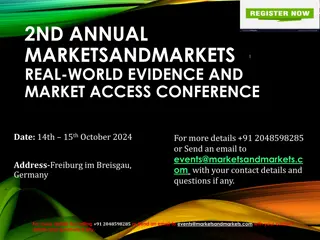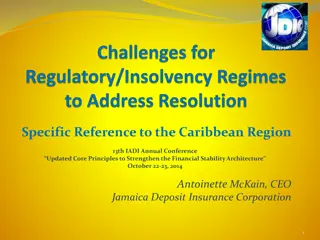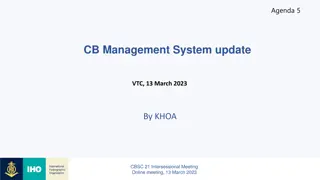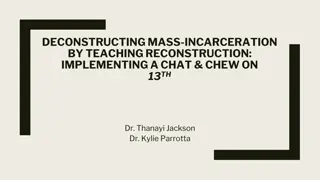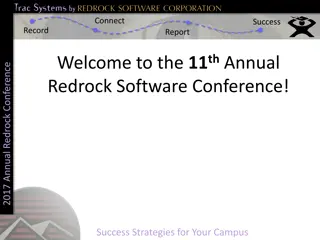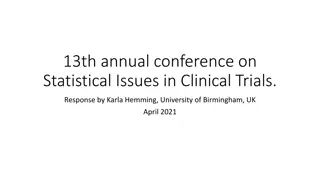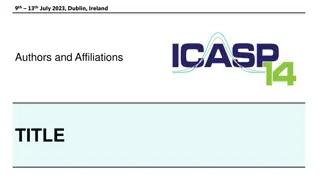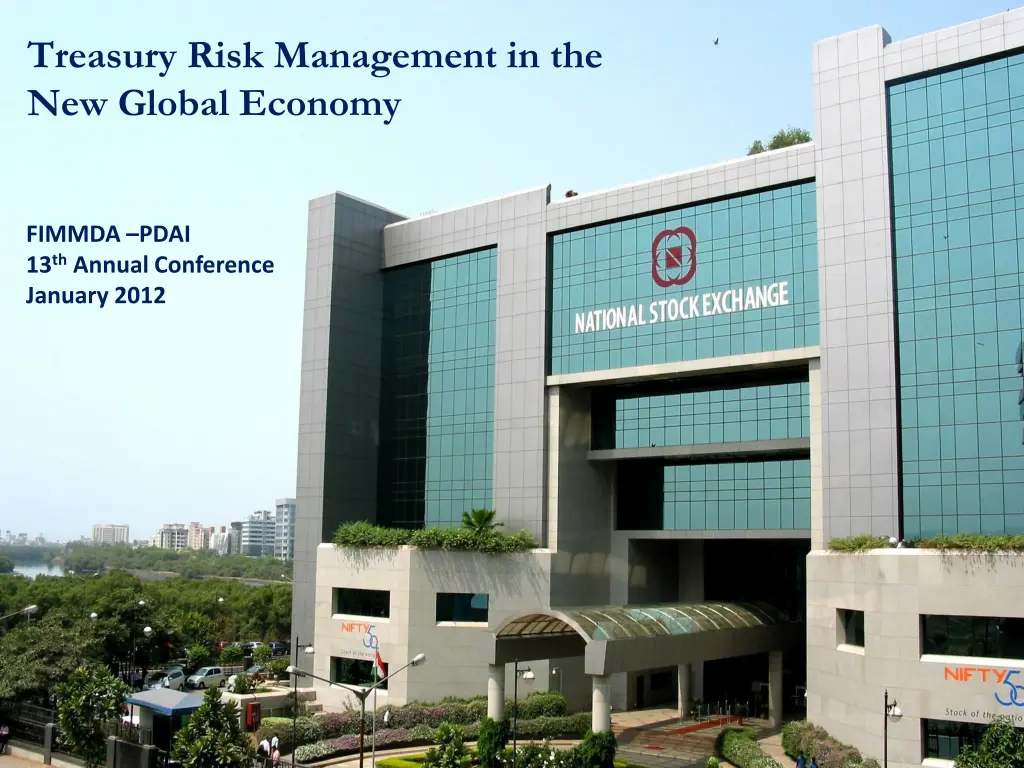
Understanding Treasury Risk Management in Equity Derivatives Market
Explore the trends and strategies in treasury risk management within the equity derivatives market, including various instruments like IRDs, interest rate swaps, and futures. Gain insights into the global perspective and evolution of interest rate derivatives over the years, with a focus on key aspects such as product design, turnover, and regulatory frameworks.
Download Presentation

Please find below an Image/Link to download the presentation.
The content on the website is provided AS IS for your information and personal use only. It may not be sold, licensed, or shared on other websites without obtaining consent from the author. If you encounter any issues during the download, it is possible that the publisher has removed the file from their server.
You are allowed to download the files provided on this website for personal or commercial use, subject to the condition that they are used lawfully. All files are the property of their respective owners.
The content on the website is provided AS IS for your information and personal use only. It may not be sold, licensed, or shared on other websites without obtaining consent from the author.
E N D
Presentation Transcript
nsccl Trends in Equity Derivatives Market Treasury Risk Management in the New Global Economy FIMMDA PDAI 13th Annual Conference January 2012
nsccl Treasury risk management Multiple instruments Forward Rate Agreements Interest rate swaps Futures Caps, Floors, Collars Swaptions and options Important Exchange traded instruments Interest rate futures Both short term and long term
nsccl Interest Rate Derivatives -Product & Global Perspective Interest rates contracts were first traded in US in 1975. Used in response to growing needs for tools that protect against interest rate volatility IRF are the most widely traded derivative instrument in the world. The notional amount outstanding as on Sep-2011 in IRF is 22.52 times more than that of equity index futures. Source BIS
nsccl IRD 2003 version Started first in the Equity derivatives segment in June 2003 Both short term and long term Based on ZCYC curve Cash settlement Issues of basis risk reported by the market Difference in yield between ZCYC and market yields PDs were permitted to trade; banks can only hedge Issues on hedge ratio Product design and capability to trade as main issues
nsccl Turnover in IRDs (2003) 160 Turnover in Rs.Crs Highest turnover: Rs.140 crs. Last trade date : Aug 26, 2003 140 120 100 80 60 40 20 0 01-Aug-03 03-Aug-03 05-Aug-03 07-Aug-03 09-Aug-03 11-Aug-03 13-Aug-03 15-Aug-03 17-Aug-03 19-Aug-03 21-Aug-03 23-Aug-03 25-Aug-03 02-Jul-03 04-Jul-03 06-Jul-03 08-Jul-03 10-Jul-03 12-Jul-03 14-Jul-03 16-Jul-03 18-Jul-03 20-Jul-03 22-Jul-03 24-Jul-03 26-Jul-03 28-Jul-03 30-Jul-03 24-Jun-03 26-Jun-03 28-Jun-03 30-Jun-03
nsccl IRF on basket of GOI bonds (2004) SEBI approval in Jan 2004 Contracts based on a basket of bonds 9 to 11 years maturity Settlement based on their YTMs Cash settled Reconstitution and revision of basket Polling as an alternative Product was not launched Design issues addressed partially
nsccl The current form Regulatory framework RBI SEBI Technical committee report of June 17, 2009 Product Ten year notional bond product Notional coupon of 7% with semi-annual Compounding Contract size to be Rs. 2 lakhs 4 Fixed quarterly contracts for entire year ending March, June, Sep & Dec Trading Introduced in Currency Derivative Segment Trading hours 9:00 AM to 5:00 PM Last trading day to be 7th business day preceding the last business day of the delivery month Membership Members in currency derivatives can become clearing & trading members Members in equity derivatives can trade through CM in currency segment
nsccl IRF 2009 contd. Settlement Physical Settlement for the first time for an exchange traded derivative The owner of the short position has right to decide when to initiate delivery Settlement cycle: T+2 Risk Management Collaterals in currency derivatives segment SPAN based margining Daily mark-to-market T Bill futures in July 2011
nsccl IRF 10 year product 300 250 Turnover in Rs.Cr. No volumes after April 26, 2011 Highest volumes: Rs.267 crs. 200 150 100 50 0
nsccl 91 day T Bill futures 800 700 Turnover in Rs.Cr. Last date of trade: 31-0ct-2011 Highest volumes: Rs.730 crores 600 500 400 300 200 100 0 12-Sep-11 14-Sep-11 16-Sep-11 20-Sep-11 22-Sep-11 26-Sep-11 28-Sep-11 4-Jul-11 6-Jul-11 8-Jul-11 1-Aug-11 3-Aug-11 5-Aug-11 9-Aug-11 11-Aug-11 16-Aug-11 18-Aug-11 23-Aug-11 25-Aug-11 29-Aug-11 3-Oct-11 5-Oct-11 12-Jul-11 14-Jul-11 18-Jul-11 20-Jul-11 22-Jul-11 26-Jul-11 28-Jul-11 10-Oct-11 12-Oct-11 14-Oct-11 18-Oct-11 20-Oct-11 24-Oct-11 26-Oct-11 31-Oct-11 2-Sep-11 6-Sep-11 8-Sep-11
nsccl Interest Rate Futures (IRF)- Product Snap Shot Product specification 2 Yr and 5 Yr IRF* Settlement Mechanism Final Settlement Price 10 Yr IRF Physical Settled Based on price of CTD bond Based on RBI 91 DTB futures Cash Settled Cash Settled Based on Polled Yield by FIMMDA weekly auction yield Underlying Notional security with 7% coupon semiannual Notional security with 7% coupon semiannual 91 Day GOI T-Bill Underlying Basket 1.5 yrs to 2.5 yrs 4.5 yrs to 5.5 yrs Same as Underlying GOI security market Last Thursday of the expiry month 7.5 yrs to 15 yrs No basket Quotation Same as Underlying GOI security market Two business day preceding the last business day of the delivery month Quarterly Annualized quotation Last Wednesday of the expiry month Expiry day Contract Months Monthly Monthly & Quarterly * Recently approved by SEBI/RBI
nsccl Reasons for poor response Lack of volumes not due to lack of interest Market participants have reported Obtaining of internal approvals System developments Risk and compliance set-ups Test deals Efforts of Exchange Awareness seminars Product changes Reasons cited by market Illiquidity/Changing liquidity pattern in underlying GOI securities. Mandatory physical settlement.
nsccl Illiquidity of underlying GOI Very few bonds in the basket are liquid Many times, only one bond Others, not so liquid Changing liquidity pattern Arbitrage free settlement price difficult Settlement prices based on the Cheapest to Deliver bonds CTD, not generally the most liquid Significant portion of holdings in HTM
nsccl Physical settlement Restricts participation to only those who have access to underlying Limited access and issues in market making Fear of delivery of illiquid stocks Net basis for the securities in the deliverable basket, high Substituting CTD difficult TAC report of August 2008 has recommended physical settlement to ensure convergence of the cash market price with Futures Thereby serve as a true hedge to credit-risk-free interest rate-risk exposure. Due to illiquidity, objectives are not being achieved. There is no institutional mechanism to inject liquidity in the securities in the basket. The term repo market in India Short selling
nsccl Market suggestions Cash Settlement for 10 yr IRF contracts Single benchmark GOI security as underlying Market demand for 10 Yr cash settled IRF contracts Regular issuance of underlying benchmark GOI securities Final Settlement based on traded price and not on polled price Easy access of underlying cash market to market participants of the futures market Facilitation of market making Development of underlying GOI securities market and RDM
nsccl Underlying market Limited memberships Other debt securities RDM settlement through SGL/CSGL accounts Multiple optional settlement cycles Review of RDM market design segment, market timings, trading in terms of face value, valuation prices, etc., Market making CBLO and LAF for all market participants including trading members.
nsccl Rate futures Banks are subjected to interest rate risks across various tenures. overnight, three months, six months and extending to one year, three years, five years, ten years and even say longer than that. Need for Multiple derivative products across the yield curve Derivative products on Benchmark Interest Rates ? Existing issues of illiquidity of the underlying and physical settlement may not be applicable? Globally derivatives on interest rates are being well traded. For example, Eurodollar futures at CME, Euribor Futures at NYSE-Liffe, One-Day Interbank Deposit Futures Contract at BM&F Bovespa etc. Derivatives on interest rates namely, MIBOR and MIFOR ?
nsccl pen Challenges and Road Ahead Challenges Participation by all classes of investors Illiquidity :Development of underlying debt market Availability of large no of products Revision of Product framework to suite the needs of the participants Road Ahead Step towards integration of Indian Derivatives market with Rest of the World Collaborative efforts on the part of market participants, exchanges and regulators to develop the product
nsccl THANK YOU



